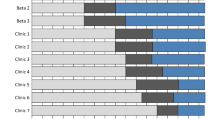Abstract
Purpose
The ACGME (US) and The European Working Time Directive (UK) placed work-hour restrictions on medical trainees with the goal of improved patient safety. However, there has been concern over a potential decrease in medical education. Orthopaedic training is the focus of this study. We examined previously published subjective and objective data regarding education and work-hour restrictions and developed the questions: Do specific perceptions emerge within the subjective studies examined? Are there objective differences in educational measures before and after work-hour restrictions? Is there a difference between the subjective and objective data?
Methods
A systematic review was conducted via MedLine, regarding orthopaedic studies in the USA and UK, with reference to work-hour restrictions and education.
Results
Subjective survey studies demonstrate that residents and attending physicians have a negative response to work-hour restrictions because of the perceived impact on their overall education and operating room experience. Conversely, limited objective studies demonstrated no change in operative volume before or after implementation of restrictions.
Conclusions
This review highlights the need for more objective studies on the educational implications of work-hour restrictions. Studies to date have not demonstrated a measurable difference based on case logs or training scores. Opinion-based surveys demonstrate an overall negative perception by both residents and attending physicians, on the impact of work-hour restrictions on orthopaedic education. Current published data is limited and stronger evidence-based data are needed before definitive conclusions can be reached.



Similar content being viewed by others
References
Friedman RC, Bigger JT, Kornfeld DS (1971) The intern and sleep loss. N Engl J Med 285(4):201–203
Lerner BH, (2006) A case that shook medicine. http://www.washingtonpost.com/wp-dyn/content/article/2006/11/24/AR2006112400985.html. Accessed 12 Apr 2013
Fitzgerald JE, Caesar BC (2012) The European working time directive: a practical review for surgical trainees. Int J Surg 10(8):399–403
Friedlaender GE (2006) The 80-hour duty week: rationale, early attitudes, and future questions. Clin Orthop Relat Res 449:138–142
Zuckerman JD, Kubiak EN, Immerman I, Dicesare P (2005) The early effects of code 405 work rules on attitudes of orthopaedic residents and attending surgeons. J Bone Joint Surg Am 87(4):903–908
Pellegrini VD Jr, Peabody T, Dinges DF, Moody J, Fabri PJ (2005) Symposium resident work-hour guidelines. A sentence or an opportunity for orthopaedic education? J Bone Joint Surg Am 87(11):2576–2586
Barrack RL, Miller LS, Sotile WM, Sotile MO, Rubash HE (2006) Effect of duty hour standards on burnout among orthopaedic surgery residents. Clin Orthop Relat Res 449:134–137
Kusuma SK, Mehta S, Sirkin M et al (2007) Measuring the attitudes and impact of the eighty-hour workweek rules on orthopaedic surgery residents. J Bone Joint Surg Am 89(3):679–685
Peabody T (2006) The effect of work hour restrictions on the education of orthopaedic surgery residents. Clin Orthop Relat Res 449:128–133
Immerman I, Kubiak EN, Zuckerman JD (2007) Resident work-hour rules: a survey of residents’ and program directors’ opinions and attitudes. Am J Orthop (Belle Mead NJ) 36(12):E172–E179, discussion E179
Ranawat AS, Dirschl DR, Wallach CJ, Harner CD (2007) Symposium. Potential strategies for improving orthopaedic education. Strategic dialogue from the AOA Resident Leadership Forum Class of 2005. J Bone Joint Surg Am 89(7):1633–1640
Weatherby BA, Rudd JN, Ervin TB, Stafford PR, Norris BL (2007) The effect of resident work hour regulations on orthopaedic surgical education. J Surg Orthop Adv 16(1):19–22
Mir HR, Cannada LK, Murray JN, Black KP, Wolf JM (2011) Orthopaedic resident and program director opinions of resident duty hours: a national survey. J Bone Joint Surg Am 93(23):e1421–e1429
Egan C, Elliott R, Fleming P (2012) European working time directive and the use of simulators and models in Irish orthopaedics. Ir J Med Sci 181(1):143–146
Fitzgibbons SC, Chen J, Jagsi R, Weinstein D (2012) Long-term follow-up on the educational impact of ACGME duty hour limits: a pre-post survey study. Ann Surg 256(6):1108–1112
Pappas AJ, Teague DC (2007) The impact of the accreditation council for graduate medical education work-hour regulations on the surgical experience of orthopaedic surgery residents. J Bone Joint Surg Am 89(4):904–909
Baskies MA, Ruchelsman DE, Capeci CM, Zuckerman JD, Egol KA (2008) Operative experience in an orthopaedic surgery residency program: the effect of work-hour restrictions. J Bone Joint Surg Am 90(4):924–927
Froelich J, Milbrandt JC, Allan DG (2009) Impact of the 80-hour workweek on surgical exposure and national in-training examination scores in an orthopedic residency program. J Surg Educ 66(2):85–88
Wilson T, Sahu A, Johnson DS, Turner PG (2010) The effect of trainee involvement on procedure and list times: a statistical analysis with discussion of current issues affecting orthopaedic training in UK. Surgeon 8(1):15–19
Namdari S, Baldwin KD, Weinraub B, Mehta S (2010) Changes in the number of resident publications after inception of the 80-hour work week. Clin Orthop Relat Res 468(8):2278–2283
Moonesinghe SR, Lowery J, Shahi N, Millen A, Beard JD (2011) Impact of reduction in working hours for doctors in training on postgraduate medical education and patients’ outcomes: systematic review. BMJ 342:d1580
Temple J (2010) Time for training: a review of the European WorkingTime Directive on the quality of training. Department of Health, London
Daniels AH1, McDonnell M, Born CT et al (2013) Critical analysis of a trauma fellowship-modeled, six-year orthopaedic surgery training program. J Bone Joint Surg Am 95(15):e108
Author information
Authors and Affiliations
Corresponding author
Ethics declarations
Sources of funding
The authors report no external funding source for this study.
Conflict of interest statement
Each author certifies that he or she has no commercial associations (e.g., consultancies, stock ownership, equity interest, patent/licensing arrangements, etc.) that might pose a conflict of interest in connection with the submitted article.
Rights and permissions
About this article
Cite this article
Mauser, N.S., Michelson, J.D., Gissel, H. et al. Work-hour restrictions and orthopaedic resident education: a systematic review. International Orthopaedics (SICOT) 40, 865–873 (2016). https://doi.org/10.1007/s00264-015-3045-7
Received:
Accepted:
Published:
Issue Date:
DOI: https://doi.org/10.1007/s00264-015-3045-7




